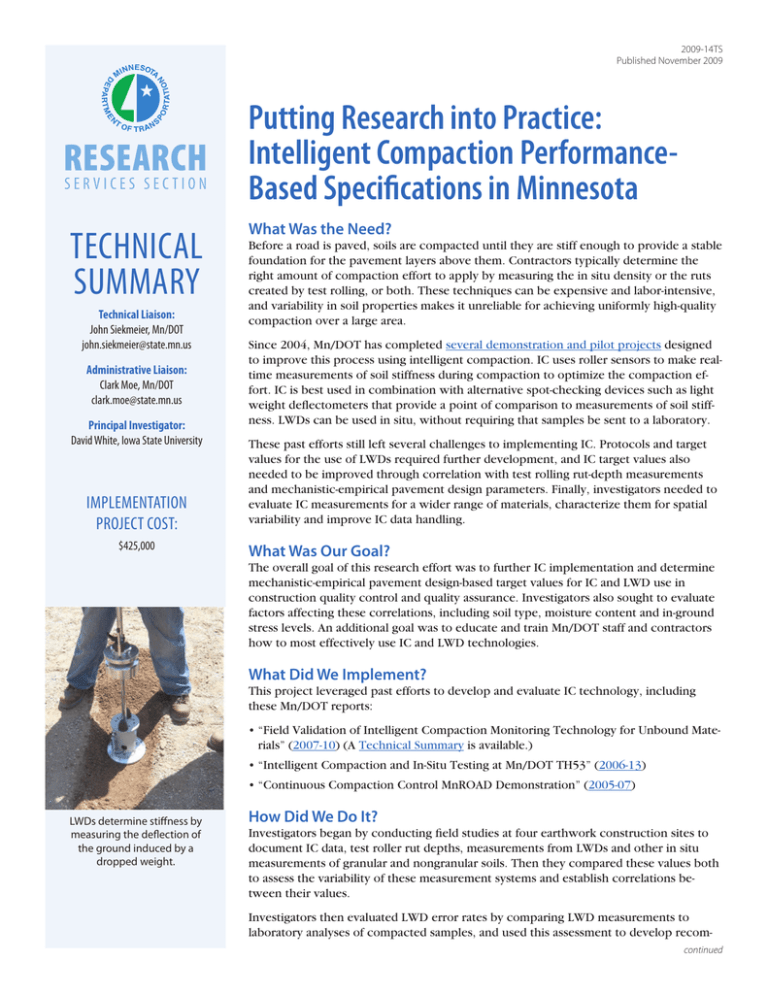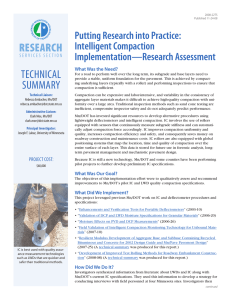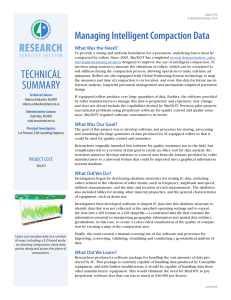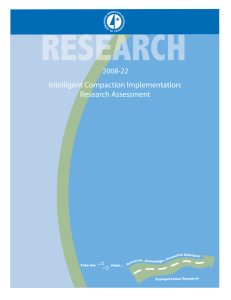TECHNICAL RESEARCH Putting Research into Practice: Intelligent Compaction Performance-
advertisement

2009-14TS Published November 2009 RESEARCH SERVICES SECTION TECHNICAL SUMMARY Technical Liaison: John Siekmeier, Mn/DOT john.siekmeier@state.mn.us Administrative Liaison: Clark Moe, Mn/DOT clark.moe@state.mn.us Principal Investigator: David White, Iowa State University IMPLEMENTATION PROJECT COST: $425,000 Putting Research into Practice: Intelligent Compaction PerformanceBased Specifications in Minnesota What Was the Need? Before a road is paved, soils are compacted until they are stiff enough to provide a stable foundation for the pavement layers above them. Contractors typically determine the right amount of compaction effort to apply by measuring the in situ density or the ruts created by test rolling, or both. These techniques can be expensive and labor-intensive, and variability in soil properties makes it unreliable for achieving uniformly high-quality compaction over a large area. Since 2004, Mn/DOT has completed several demonstration and pilot projects designed to improve this process using intelligent compaction. IC uses roller sensors to make realtime measurements of soil stiffness during compaction to optimize the compaction effort. IC is best used in combination with alternative spot-checking devices such as light weight deflectometers that provide a point of comparison to measurements of soil stiffness. LWDs can be used in situ, without requiring that samples be sent to a laboratory. These past efforts still left several challenges to implementing IC. Protocols and target values for the use of LWDs required further development, and IC target values also needed to be improved through correlation with test rolling rut-depth measurements and mechanistic-empirical pavement design parameters. Finally, investigators needed to evaluate IC measurements for a wider range of materials, characterize them for spatial variability and improve IC data handling. What Was Our Goal? The overall goal of this research effort was to further IC implementation and determine mechanistic-empirical pavement design-based target values for IC and LWD use in construction quality control and quality assurance. Investigators also sought to evaluate factors affecting these correlations, including soil type, moisture content and in-ground stress levels. An additional goal was to educate and train Mn/DOT staff and contractors how to most effectively use IC and LWD technologies. What Did We Implement? This project leveraged past efforts to develop and evaluate IC technology, including these Mn/DOT reports: • “Field Validation of Intelligent Compaction Monitoring Technology for Unbound Materials” (2007-10) (A Technical Summary is available.) • “Intelligent Compaction and In-Situ Testing at Mn/DOT TH53” (2006-13) • “Continuous Compaction Control MnROAD Demonstration” (2005-07) LWDs determine stiffness by measuring the deflection of the ground induced by a dropped weight. How Did We Do It? Investigators began by conducting field studies at four earthwork construction sites to document IC data, test roller rut depths, measurements from LWDs and other in situ measurements of granular and nongranular soils. Then they compared these values both to assess the variability of these measurement systems and establish correlations between their values. Investigators then evaluated LWD error rates by comparing LWD measurements to laboratory analyses of compacted samples, and used this assessment to develop recomcontinued “This project provided a vast amount of field data, and its analysis verifies the value of performancebased quality assurance. Implementation can be confidently accelerated with additional projects that will help Mn/DOT continue to refine its IC specifications.” –John Siekmeier, Mn/DOT Senior Research Engineer “This project demonstrated the potential for IC technologies to impact contractor process control and provide high-value data usable for both quality control and quality assurance with proper correlation.” –David White, Director, Earthworks Engineering Research Center, Iowa State University Produced by CTC & Associates for: Minnesota Department of Transportation Research Services Section MS 330, First Floor 395 John Ireland Blvd. St. Paul, MN 55155-1899 (651) 366-3780 www.research.dot.state.mn.us IC rollers are equipped with a Global Positioning System to map the location, time and force of compaction. This data is stored for future use in forensic analysis, long-term pavement management and mechanistic-empirical pavement design. mended IC and LWD specifications and testing protocols. Laboratory methods included soil index, compaction, strength and resilient modulus tests. What Was the Impact? Results showed that IC and in situ point measurements are alternatives to density testing and test rolling in many situations. Investigators calculated site-specific target values for IC, the LWD and shear strength. They also developed detailed empirical correlations between IC, the LWD and other in situ test devices such as dynamic cone penetrometers. Investigators also developed four IC specification options: Three do not require on-site roller calibration, and one requires on-site calibration of IC and in situ point measurements. The latter option has the advantages of quantifying risk, establishing a framework for a performance specification and providing information for incentive-based pay. Finally, early in the project investigators conducted five training seminars to give Mn/DOT staff and contractors information about and experience using IC and the LWD. These results provided a framework for linking mechanistic-empirical pavement design to construction quality assurance and quality control. What’s Next? This project is part of a larger, ongoing Mn/DOT effort to implement IC technology; an evaluation of some components of this effort was issued in Mn/DOT Report 2008-22, “Intelligent Compaction Implementation: Research Assessment.” Minnesota is also a participant in a multistate pooled fund effort to produce IC field demonstrations. For future phases of this effort, investigators recommend establishing additional pilot projects and an IC training and certification program. Report 2009-35, “Procedures to Use and Manage IC Data in Real Time,” will describe new software to make it easier to provide real-time data analysis during the construction process and to archive IC data for future use. This Technical Summary pertains to Report 2009-14, “Implementation of Intelligent Compaction Performance Based Specifications in Minnesota,” published July 2009. The full report can be accessed at http://www.lrrb.org/PDF/200914.pdf. The three reports being implemented by this study as referenced above can be accessed at http://www.lrrb.org/PDF/200710.pdf, http://www.lrrb.org/PDF/200613.pdf and http://www.lrrb.org/PDF/200507.pdf. Information on current IC efforts is available at http://www.dot.state.mn.us/materials/researchic.html.








